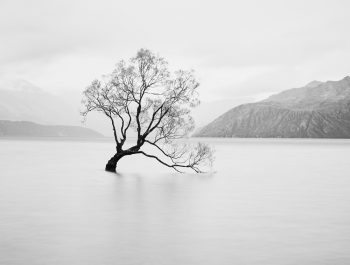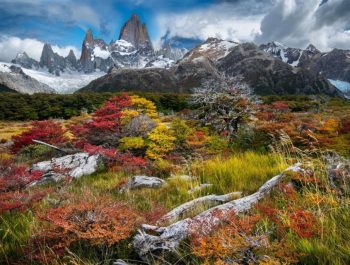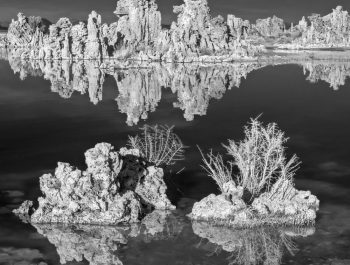Creating A Sense Of Space In Your Compositions
Outdoor Portraiture
In recent months while attending several online and in the classroom photography critique sessions, it occurred to me how many of the participants suggested cropping photos – moving in closer, as it were – as a fix for the photograph that was being presented to the group. More than half of the suggested cropping (to get closer to the actual subject) in my opinion, would redirect the composition towards a snap-shot like appearance. That is an image that can lack attention to some details, be technically unbalanced (i.e. as in the chromatic and luminosity variables of a photograph) and can also lack other visual cues in creating a dynamic composition. In other words, sometimes cropping to get closer to the main subject can actually diminish an already well balanced thoughtful composition.
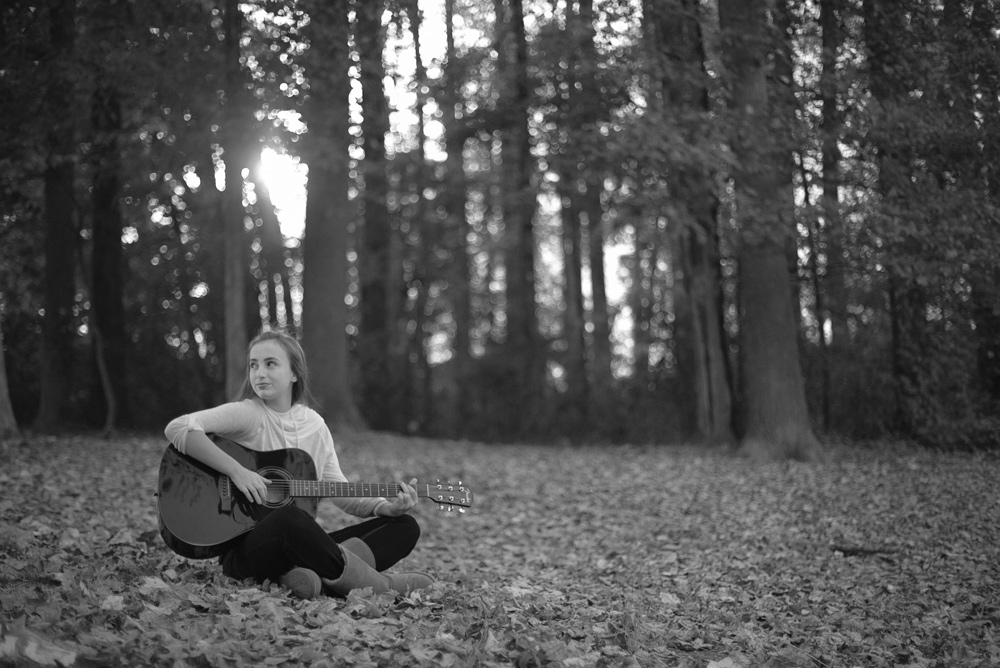
One of the most popular lessons in teaching how to create powerful compositions is known as the “Rule of Thirds”. When instructing students of photography, I briefly review this concept, but as an alternative, I concentrate on showing the virtues of practicing visualization. Through the practice of visualization, we learn to experience the many nuances we miss in our hurried pace: learning to see, feel, smell and even taste, from our immediate environment, helping to unleash our creativity from behind the lens. No doubt our senses and brain function incredibly efficient as a team, taking in and then processing data and presenting us a front-row seat to the world. But how do we capture this “Landscape” as seen through the lens of our camera, and then share with others our experiences through photographs? Klaus Berger (1901-2000) was a German Art historian: a paraphrase of his statement on using open space in both paintings and photography, ‘unpeopled negative space, in fact, plays an important part in a carefully planned, overall composition, which reflects a dynamic and rhythmic equilibrium of patterns’. Berger continued to cite this type of perspective is integral in Japanese prints 1.
Sometimes a solitary subject can lack the presence needed to throw forth the impact the artist intended when composing. My lesson plans always include discussions on the use of “space”, an essential component in creating dynamic compositions. Elaborating on the environment surrounding the subject can result in projecting more “emotional value” to a photograph meaning: viewing more of the space in which the subject resides, helps the viewer develop an interpretation or narrative.
Portraiture: The heart of a musician
In an attempt to try and capture the unique individuality of this 15-year-old sitter Fig.1 (above), I first suggested this young musician have her guitar accompany the photoshoot. Easy to realize this established a strong sense of security between the wide-open space of the location, our subject, and the photographer. Regardless if you know the person you are photographing, there can sometimes be a great deal of apprehension which will ultimately be revealed by the lens. A relaxed and trusting relationship between the photographer and their sitter goes a long way in producing strong photographic compositions that feel less staged and more organic.
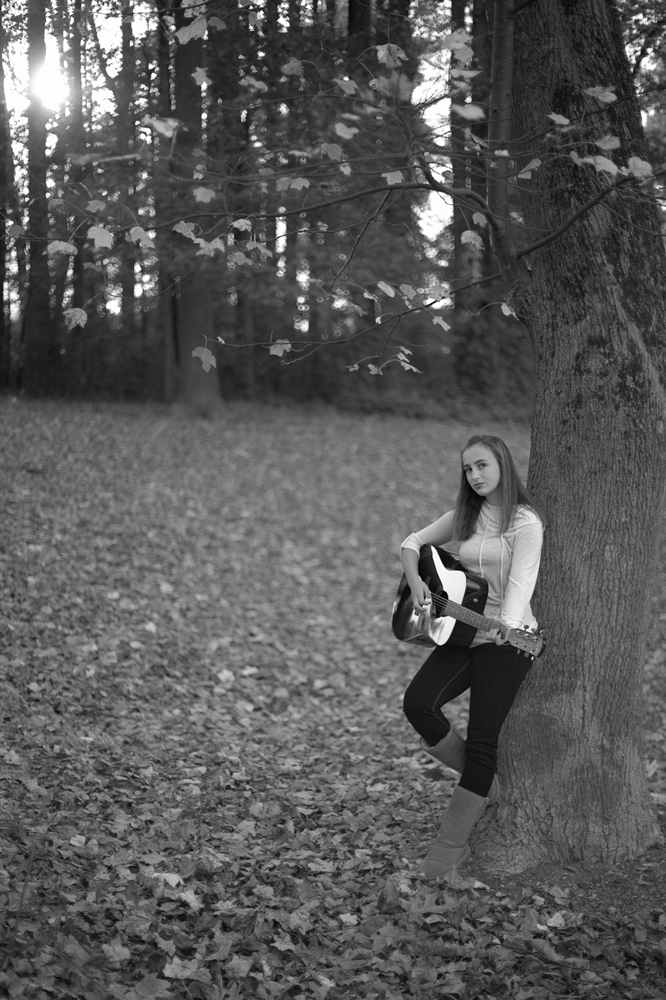
The shot was captured digitally with a Canon 5D Mark II. Canon F/1.4 50mm (my go-to-lens for both shooting flora and portraits) ISO-640 because the sun was low in the sky and illumination was limited; this said, I choose this time of day because of the lighting: soft and meditating which characterizes the whole composition and as an artist, what I was trying to achieve visually. Triggered at 1/4000sec, hand-held and manual focus. Of course I bracketed 2 or 3 shots with different aperture settings.
Fig.1 The young lady is relaxed – very comfortable – I asked her to look away from me – she turned 3 or 4 different ways, but I like this the best. The space in front of our sitter (right-side of the photograph) opens up the scene to help reveal the tranquil mood. The sitters gaze beyond the left-side frame adds an element of mystery that helps develop the overall emotional vibe, but also helped reveal the subjects character through expression. Fig.2 our musician chills and begins strumming the strings on her guitar – again, isolating her to only a fraction of the frame, you can almost hear her tune in this visual-only presentation.
Including the extra space in these photographs is not exactly a portrait in the usual sense, non the less, it will perhaps, allow viewers’ to gain a little more insight into this musician’s heart.
Portraiture: Rappelling in LaFayette, Georgia
An hour north of Atlanta, Georgia is the city of LaFayette. Known for its numerous caves, including Petty John’s Cave, and also a great spot for beginner rock climbing and rappelling. My son, Max and his wife Ashley asked me to join them to capture photographs of them rappelling from a 60-foot waterfall. From roadside we hiked a mile – wish I had remembered to take my hiking shoes – big mistake, as the sneakers had little in the form of grip. Max and Ashley took the high path to the top of a beautiful waterfall while I hiked along the riverbed and took position. I shot off about 24 frames and chose the one illustrated in Fig.3 and Fig.4 for our examples.
The cropped photo in Fig.3 illustrates a nicely composed picture. The subject is off-centered to allow viewers to see the rock formations that identify the space in which Max is rappelling. But, something is missing in Fig.3 that does not relay the drama I experienced when capturing this image. We need to visualize and grab more of the environment that embraces and defines the drama of the moment.
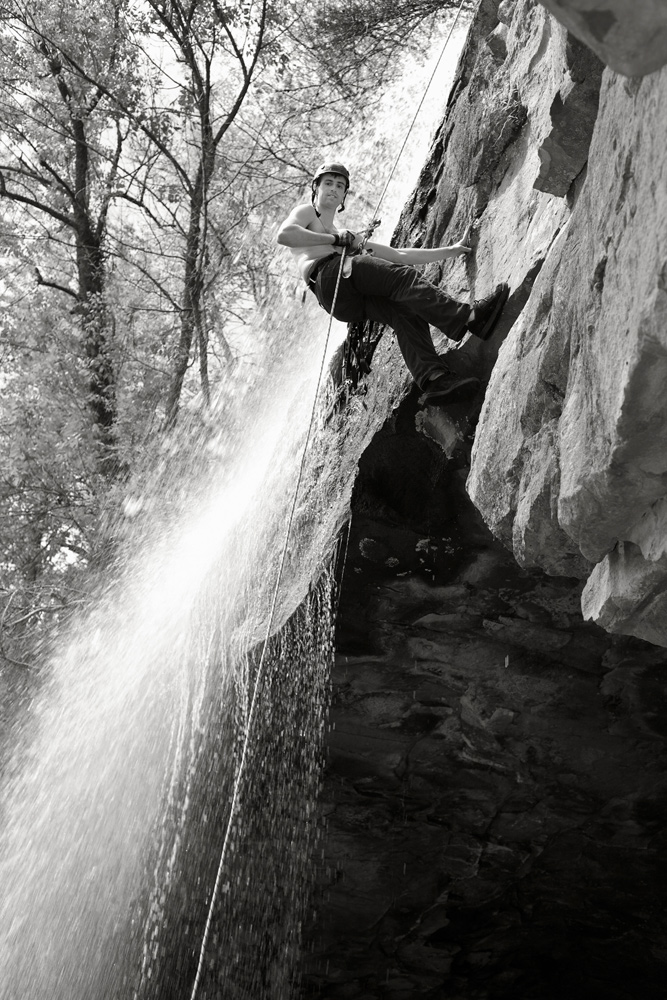
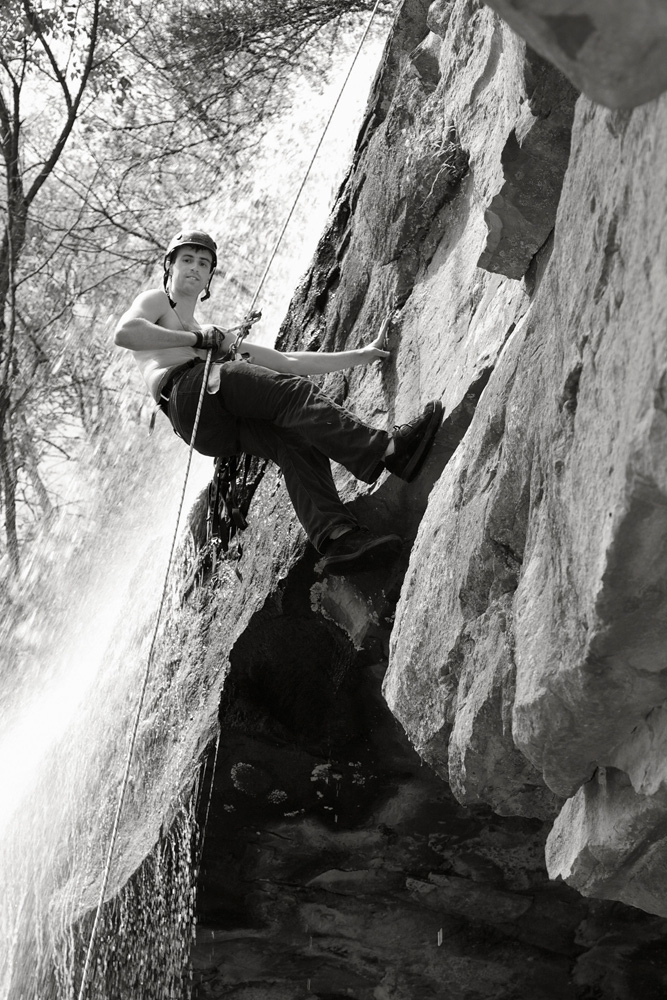
Alternatively, in Fig.4 we can immediately sense the danger involved rappelling this waterfall: this photograph reveals height, the menacing rocks and cascading water confronting the subject. Backing off the subject and taking in the whole scene reveals more of the drama experienced on-site.
I captured the scene with a Canon f/1.4 50mm lens; formatted vertically – holding the camera in a vertical or portrait position – captures the drama of the subject skillfully, and I may add, carefully, rappel this jagged 60-foot waterfall! Taking in more of the landscape gives the viewer more information to form an interpretation.
Warning: Before we continue, let me share a painful reminder when not being careful during a photoshoot can get you in trouble: sitting on top of a small group of rocks layered on the river-bed, just outside the full spray of the cascading water, I just finished capturing the photographs in the above illustration, and not paying attention after sitting so long, standing up, I slipped, dramatically falling 3 feet onto my back – cushioned only by solid rock! My Canon 5D Mark II flew in the air and landed some 10 feet to my left – thankfully, free from the gushing water – but, broke the 50mm lens! Banged up, but functional, I limped out of the forest and spent the next week recuperating in bed. Lesson: be cognizant of your immediate surroundings, not for just taking great photographs, but keeping yourself and your equipment safe from harm.
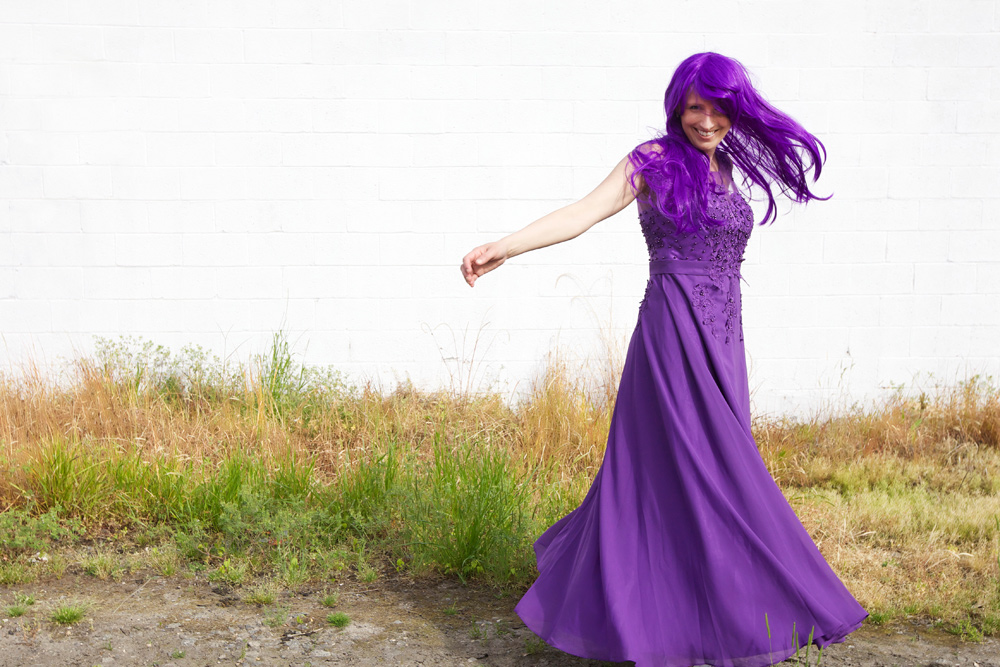
Portraiture: Wild and Sassy
The last example (Figure 5) exemplifies a fashion-oriented composition: similar to Figure 1 at the beginning of this tutorial, we have a lot of space (and in this example, literally “white space”). It is an aesthetic I favor in many of my portraitures because in my opinion, I feel it provides a sense of drama, and what I talked about earlier, opening up a scene to define the space our subject is in. Similar to Fig 1 at the beginning of this tutorial, I place the model in an unconventional position, as in both compositions the models are facing toward the smaller portion of the frame, instead of the more conventional manner of looking or facing towards the larger (known) space. The whole gestalt brings this sense of drama or mystery to the photograph. Errol Morris suggests “Photographs are a ‘swatch of the reality of a 2-dimensional world’. What lay outside the frame?” 2 Morris’s book is one of a few that inspired me to look outside the box in finding new methods to induce a reaction from viewers’. Another is the study of Gestalt, which we can discuss in a future article.
Using manual focus this digital capture was handheld as I moved with the dancing, swirling, purple goddess – the scope of view 35mm, F/7.0 at 1/1000sec. ISO was dialed in at 400 for the available light. The cameras onboard exposure meter muddied the whites leaving the wall-less alive thus muting the overall composition. As a consequence, the wall was “dodged” to bring out more brilliance representative of the scene at the time of capture. Additionally, the purple dress and hair also were dodged to balance with the brilliance of the white wall.
I hope this short piece helps inspire you to artistically “open up” your field of view through the viewfinder allowing for a wider ‘swatch of reality’ in exploring your creativity from behind the lens. I look forward to your comments. Thank you.
1 Early Influences of Photography on Art – Journal of Art in Society 2012-2013
2 Excerpt from Errol Morris discussions on his book, Believing is seeing: observations on the mysteries of photography
Lance Lewin
November 2019
Atlanta, Georgia
For the most part, my inspiration from behind the viewfinder comes from a richly filled combination of studying the pioneers of photography in the mid to late 19th century and masters of the 20th century, (e.g., Julia Margret Cameron, Alfred Stieglitz, Ansel Adams, and Bob Kolbrener, for just four examples) while also studying art history, drawing and design, all in the pursuit of developing my own artistic narratives. Though a lot of my work cannot be deemed as “Straight Photography”, nonetheless, I stay clear of trends that can lead to what some refer to as hyper-reality and composite alternatives, instead, maintaining a photographic canvas that balances between modernist and pictorial aesthetics that evoke a sense of reality and authenticity. Current Projects: Currently, personal visual projects are focused in two areas of study: 1. interpretations of nature through the lens of Japanese aesthetics, and 2. a more specific interest in how people navigate around each other especially in a city environment: here my camera is pointed down or positioned close to the ground inviting the viewer to study this normally insipid perspective with renewed inquisitiveness. This change in perspective reveals the human impact and pace of everyday life; patterns we normally do not see in our hurried pace, as we stride from one place to the next. Glimpsing from one image to another reveals the bio-mechanical similarities in our stride, while unexpectedly exposing proof of our intimacy to each other as we dispense personal borders to walk near, around, and sometimes, seemingly through the people that surround us. Philosophy of Photography: Lastly, on the philosophical side of photography, I argue we have been witnessing a paradigm shift in how people approach and contemplate most photographic images they encounter: in this sense, spectators are aware technologies exist that can digitally manipulate image files (and including an increase in the use of AI based photographic software) thus giving the spectator pause in contemplating an images epistemic value. As such, my philosophical research is to eventually introduce alternative photographic categories in helping to differentiate between the wide scope of traditionally based photographic work and, for example, work that may be constructs of “composite” techniques or “conceptual” based photographic images, for two examples. Please, visit my website to learn a little more about my perspectives from behind the lens and teaching philosophy. http://visualizingart.com/ • Photographic Society of America (PSA) Global B&W Photography Mentor • PSA South Atlantic Area Membership Director • Contributing writer for PhotoPXL.com • International Visual Sociology Association (IVSA) North American & Canada Think Tank • Past Board Member at Gilmer Arts Gallery in Ellijay, Georgia • Past Photography Curator at Gilmer Arts Gallery in Ellijay, Georgia • Past Commissioner on the City of Kennesaw, Ga Art Counsel • Mayer School of Fashion & Design (the school no longer operates) • Continuing education at FIT (Pattern making and fabric technology) • Continuing education at Albany State University, Georgia (Art) • Retired Garment and Telecom industry Business Owner (40 years)






